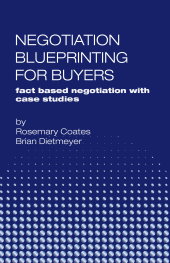An anchor is a starting point for one aspect of a negotiation or, in some instances, an entire negotiation. An anchor can be true or false, appropriate or inappropriate, in any given negotiation.* Nevertheless, only anchors that are both true and appropriate can be beneficial to both you and your customer, as only such anchors will enable you to create value.
 In sales negotiations, there are two types of anchors - opening offers and other items - both of which can have an enormous impact on the outcome of a business negotiation. On the very basic level, opening offers can be defined as the first offer put on the table by either party. It could be you saying, "We always sell our Gizmos for $15 per unit." Or your customer may say, "We never pay more than $12 per unit for Gizmos."
In sales negotiations, there are two types of anchors - opening offers and other items - both of which can have an enormous impact on the outcome of a business negotiation. On the very basic level, opening offers can be defined as the first offer put on the table by either party. It could be you saying, "We always sell our Gizmos for $15 per unit." Or your customer may say, "We never pay more than $12 per unit for Gizmos."
Nonopening-offer anchors almost invariably concern individual items rather than multiple ones and range anywhere from a customer deciding, arbitrarily, that they want a 12 percent discount in price this year to a customer insisting they won't pay more than they did ten years ago for a product whose price has since doubled. Although some nonopening-offer anchors are appropriate, the vast majority are either untrue or inappropriate, if not simply irrational. Some other examples include:
- Customers who anchor on the statement "I can get the same thing cheaper elsewhere." This may or may not be true, but buyers use this argument for one very good reason -- it works! In this case, it tends to anchor the negotiation on "I need to get a better price to beat the competition" rather than "I need to sell more value."
- Customers who anchor the negotiation by saying that a particular price is "beyond their budget." This may be true, but it's actually an inappropriate anchor because, in fact, the customer's budget has nothing to do with the price you set for your products or services - or at least, it shouldn't. Even so, it works as an anchor and, more often than not, to your detriment.
- Reps who give huge discounts in the fourth quarter or push overly hard on price and then move on, leaving their replacements with a customer who is already anchored on past negotiation behaviors. Although this is also an inappropriate anchor, such behaviors in these situations influence both the tone and direction of the replacements' first negotiation with the customer.
- Sales forces that publish price lists. Although this serves as a way of communicating pricing to customers, it's also inappropriate as an anchor for those firms desiring to sell value propositions or solutions, because reps still tend to be surprised when, as a result, a customer wants to anchor on price at the same time the rep is trying to anchor on value.
You and your customer can also become anchored, intentionally or otherwise, on a particular way of negotiating, which can have an impact on future negotiations. For example, we once worked with a buying organization that loved to use the old school tactic of "nibbling." Coming back after the negotiation had apparently ended to ask for a little bit more. They loved this tactic and for a very good reason - it always seemed to work for them. But when asked to think about it from the suppliers' perspective and how suppliers react to it, they realized that what they'd actually been doing was teaching their suppliers to lie to them. Because the suppliers had learned over time to expect the buyer to use this tactic, they would always hold something back. Then, when the buyer began nibbling, the suppliers would appear to be giving the buyer something more, even though they really weren't. If you've been anchored in a situation like that, it can easily take multiple negotiations to enable you and your customer to reanchor on trust, share information, trade, and ultimately create value.
I invite you to share some experiences you have had regarding anchors and anchoring in the comments box below.
* "Amateurs, Experts and Real Estate: An Anchoring and Adjustment Perspective on Property Pricing Decisions" by G. B. Northcraft and M. A. Neale, Organizational Behavior and Human Decision Process, 39, 1987.





